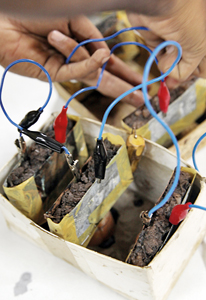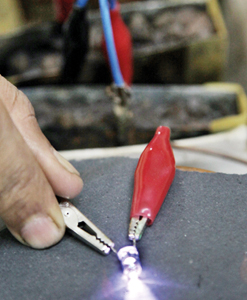Getting those batteries going on bananas
In recent weeks, daily power-cuts have reminded Sri Lankans that a steady flow of electricity can be something of a luxury. However, in parts of rural Sri Lanka even interrupted power would be a welcome step-up from having to rely on kerosene. Now, researchers from the Kelaniya University’s Physics Department have hit on what could be a novel solution to the power crisis. Galvanic cells that run off the pith of a banana tree are being dubbed ‘plantain batteries’ – they are cheap, renewable and do not require the government to invest in expensive infrastructure.

Prof. Jayasuriya
Prof. K.D.Jayasuriya is the lead researcher on the project and is a Professor in Condensed Matter Physics at the university, while Dr. R.P. Wijesundera is a Senior Lecturer in Solid State Physics. Completing the team is student Nandan Jayashantha. The process they have developed for making the batteries is simple enough – they separate the pith from the trunk of the plantain tree and then boil it, chop it up and mash it. The pulp is then stuffed in between two electrodes made of zinc and copper. Prof. Jayasuriya explains that the pith functions as the electrolytic conductor as the phosphoric acid in it reacts with the two electrodes and produces a small current.
For now, the output is less than one volt, but by hooking three or four of these devices together, the team was able to power an LED light, Prof. Jayasuriya told the Sunday Times. The team has been successful in creating a plantain battery that powered two LED lights for about 500 hours. Once a cell is made, it lasts up to 10 days if care is taken to keep the pith from drying out.
Our idea isn’t as unusual as you might think, says Dr. Wijesundera, explaining that a similar process using potatoes instead has been well investigated and widely reported (garlic is another option). Earlier this year, researchers in Saudi Arabia published a paper in the ‘Journal of Renewable Sustainable Energy’ where they showed off results that demonstrated that a potato-based battery could be twice as efficient as a standard 1.5V battery – and 26 times cheaper. However, in the debate on biofuels, the decision to use food materials to generate electricity instead is a controversial one, and financial considerations must be weighed as well before deploying such a solution in the Sri Lankan market.
“Potatoes aren’t cheap in Sri Lanka,” says Dr. Wijesundera, “so we thought to replace them with some other material.” Plantain pith which they knew to be abundant and affordable was a viable option. “Once you use a plantain pith, the cost is very much lower than a kerosene lamp,” he added. Prof. Jayasuriya reveals that the team experimented with a wide variety of local yams and tubers before settling on plantain pith. In a paper titled ‘Biodegradable Plantain Pith for Galvanic Cells’ (available online at the Institute of Physics – Sri Lanka website) they found that while best cell performances were obtained from Knodala and Jawa ala these were harder to find than the more abundant habarala petiole and plantain pith – so both the latter were selected for further studies.
 |
 |
| The banana batteries in place lighting up a small bulb with it. Pix by M.A. Pushpa Kumara | |
In the case of the plantain trees, once the fruits are harvested, the trunk is typically left to rot. “The normal plantain tree is about 6 to 7 feet high, and you can make several cells out of it,” said Prof. Jayasuriya. This is exciting news, suggesting that the batteries could serve as a cheap solution to the problem of delivering electricity to rural households. Prof. Jayasuriya explained that they were planning to make plantain pith batteries that could replace commercially available A, AA, AAA, and 9V batteries.
In the future, Prof. Jayasuriya envisions this solution being widely deployed in rural areas. “They use kerosene where electricity is not available and that can cost 30 to 40 rupees for day,” he said. “If we can design a lighting system which uses these batteries it would be much cheaper.” Most promisingly, homeowners could build the batteries themselves: “If we give them a technology, they can do it,” Dr. Wijesundera said. For would be customers, the initial costs would involve buying the zinc and copper electrode plates. Later when the zinc is consumed, it will have to be replaced. Prof Jayasuriya estimates that a 9 cm x 5 cm zinc electrode will cost Rs.100 but will last five months before it needs to be replaced.
However, the team is still very much in the process of “optimising the parameters,” and it might be a while before homeowners can start relying on their plantain trees for anything other than food.
Follow @timesonlinelk
comments powered by Disqus





















